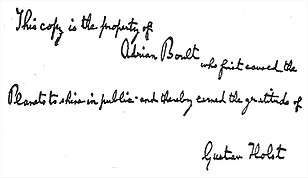Liner notes
Liner notes (also sleeve notes or album notes) are the writings found on the sleeves of LP record albums and in booklets which come inserted into the compact disc jewel case or the equivalent packaging for vinyl records and cassettes.

Origin
Liner notes are descended from the program notes for musical concerts, and developed into notes that were printed on the inner sleeve used to protect a traditional 12-inch vinyl record, i.e., long playing or gramophone record album. The term descends from the name "record liner" or "album liner". Album liner notes survived format changes from vinyl LP to cassette to CD.[1] These notes can be sources of information about the contents of the recording as well as broader cultural topics.[2]
Contents
Common material
Such notes often contained a mix of factual and anecdotal material, and occasionally a discography for the artist or the issuing record label. Liner notes were also an occasion for thoughtful signed essays on the artist by another party, often a sympathetic music journalist, a custom that has largely died out. However, the liner note essay has survived in retrospective compilations, particularly in box sets. It is also a tradition in Japan, especially for foreign artist releases. Many CD liner notes include complete song lyrics for the album.
Biographies
Liner notes now usually include information about the musician, lyrics, a personnel list, and other credits to people the musicians want to thank and people or companies involved in the production of the music. They also can give details on the extent of each musical piece, and sometimes place them in historical or social context. Liner notes for classical music recordings often provide information in several languages; if the piece includes vocal parts, they will often include a libretto, possibly also translated into several languages.
Metadata
Liner notes sometimes provide metadata that can help when cataloguing private or public collections of sound recordings. However, the information provided on liner notes varies considerably depending on the studio or label which produced the record.
Digital liner notes
Increasingly and due to the rise of digital downloads, a digital booklet is being introduced to compensate for the lack of a physical booklet. Apple Inc. also introduced iTunes LP which features interactive menus instead of simple pages.
Awards
A Grammy Award for Best Album Notes has been given annually since 1964.
See also
Notes
- Dean Biron, Writing and Music: Album Liner Notes, Portal: International Journal of Multidisciplinary Studies (Vol 8, No 1), 2011.
- Borgerson, Janet; Schroeder, Jonathan (2017). Designed for Hi-Fi LIving: The Vinyl LP in Midcentury America. Cambridge, MA: MIT Press. ISBN 978-0262036238.
References
- Dean Biron, Writing and Music: Album Liner Notes, Portal: International Journal of Multidisciplinary Studies (Vol 8, No 1), 2011.
External links
- Liner Notes in From Bach to Xenakis
- AlbumLinerNotes.com